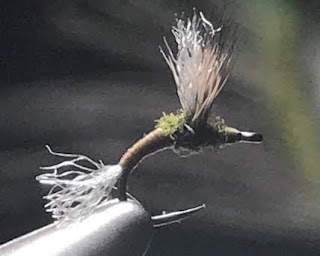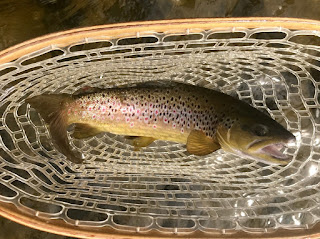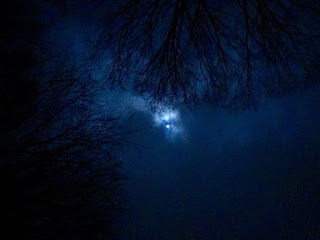As winter turns to spring, the early morning sun bounces off our pond and shines in on the bedroom ceiling. In the reflected light, dull shadows of rising water vapor dance through the rectangles, yet when I look directly at the pond, the vapor is all but invisible. On the hill above the pond, daffodils push through the carpet of decaying leaves, their bright yellow blooms undisturbed by the deer that come for a drink. These are my annual clues that our beloved spring hatches are waiting in the wings.
Over the last few weeks the little black stoneflies have been hatching in good numbers in our region. They range in size from #18's to #12. On bright days the females can be seen skittering across the water surface as they use the surface tension to pull their egg sac off the end of their abdomen. If you are lucky, you may even see an egg-laden female crawiling on riverside stones or bridges. The white egg cluster sits under the end of the wing over the end of the abdomen, which has turned a bright red color on the dorsal side. When the trout are hitting the skittering females, tie on a dark caddis dry or stonefly pattern and gently pull it across the surface where the trout have shown themselves. Often the trout will nail it in a violent take - don't use a light tippet for this exercise.

Our rivers have also been chock full of the bright orange, free-living chimarra caddis larva. These larvae are a true size #18, and the trout are fully aware that they are available to them. Fish a small orange caddis larvae behind a larger nymph for the next couple of weeks to "match" this now abundant trout food.

The first mayfly hatch of the season, the Blue-winged Olives, started to hatch a few weeks ago and will continue through most of this month. Typically, these insects hatch best on warm, overcast days for a few hours at the warmest part of the day. We've seen good numbers hatching on some days, and on others they're making themselves scarce. We prefer to fish a low riding imitation - an Improved Sparkle Emerger - in sizes #18-22. On Saturday there was a decent hatch on the PA limestone creek I was fishing in the late morning and we took a few nice browns on top. Once the wind kicked up, the hatch and the fish disappeared for the rest of the day.



Over the last few weeks the little black stoneflies have been hatching in good numbers in our region. They range in size from #18's to #12. On bright days the females can be seen skittering across the water surface as they use the surface tension to pull their egg sac off the end of their abdomen. If you are lucky, you may even see an egg-laden female crawiling on riverside stones or bridges. The white egg cluster sits under the end of the wing over the end of the abdomen, which has turned a bright red color on the dorsal side. When the trout are hitting the skittering females, tie on a dark caddis dry or stonefly pattern and gently pull it across the surface where the trout have shown themselves. Often the trout will nail it in a violent take - don't use a light tippet for this exercise.
Our rivers have also been chock full of the bright orange, free-living chimarra caddis larva. These larvae are a true size #18, and the trout are fully aware that they are available to them. Fish a small orange caddis larvae behind a larger nymph for the next couple of weeks to "match" this now abundant trout food.

Chimarra caddis larva imitation
The first mayfly hatch of the season, the Blue-winged Olives, started to hatch a few weeks ago and will continue through most of this month. Typically, these insects hatch best on warm, overcast days for a few hours at the warmest part of the day. We've seen good numbers hatching on some days, and on others they're making themselves scarce. We prefer to fish a low riding imitation - an Improved Sparkle Emerger - in sizes #18-22. On Saturday there was a decent hatch on the PA limestone creek I was fishing in the late morning and we took a few nice browns on top. Once the wind kicked up, the hatch and the fish disappeared for the rest of the day.
Blue-winged Olive Improved Sparkle Emerger
Wild brown taken on the Sparkle Emerger
Soon we should start to see the Hendrickson's and Red Quills hatching here in New Jersey. They usually start around April 10-12th and continue for a week to two with the peak lasting 4-5 days. With any luck the rivers will stay clear and we'll have a good, fishable hatch this year - our recent stream samples have yielded good numbers of maturing hendrickson nymphs.
Opening Day of trout season in New Jersey is this Saturday. It used to be a big deal for us but now that we fish all year 'round its just another day we can fish if we are so inclined to brave the crowds.
Blue moon
Sharpen your hooks!

No comments:
Post a Comment